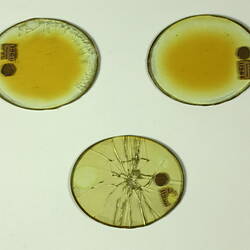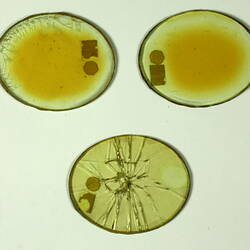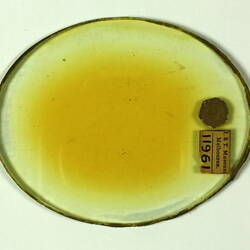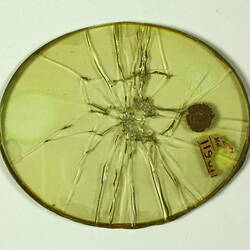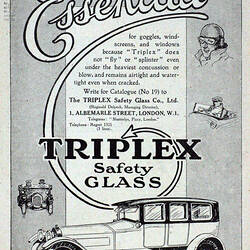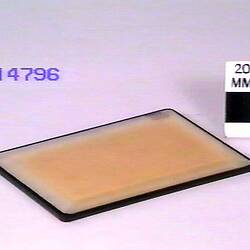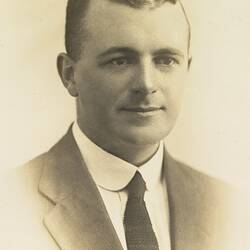Summary
Aviator's goggle glasses made of "Triplex safety glass". (Three pieces - two perfect and one shattered). Triplex glass was composed of two outer sheets of plate glass with a sheet of "Xylonite" (celluloid) sandwiched between them and cemented together with a special transparent cement. Used from 1912-1930s for the windscreens of motor cars and aeroplanes, and for goggle glass for flying and motoring goggles, gas masks and other activies where breakage might be dangerous, with a risk of eye injuries.
Presented by James Isaac Watson, father of the Australian aviation pioneer Basil George Watson, together with other artefacts salvaged from the wreckage of his plane recovered after the crash at Point Cook that killed Basil Watson on 28th March 1917.
The Triplex Safety Glass Company Ltd was established by Reginald Delpech (1881-1935) in 1912, to manufacture laminated windscreen glass for motor vehicles in Britain under French patents. The relatively high cost of manufacture compared to plain glass windscreens initially restricted demand, but following the outbreak of World War I, the product found new widespread uses for gas masks, bullet proof glass and for the rapidly growing aviation industry, being adopted for both flying goggles by pioneering aviators such as Basil Watson, and for aircraft windscreens. In 1919, the "Triplex Safety Glass" trademark was registered in Australia and Triplex safety glass cowlings and windows were adopted by Handley Page Ltd to provide weather protection for the cockpits and passenger cabins of their new aircraft built for the London-Paris passenger route. By 1924, the company had relocated to Willesden, and then in 1927 purchased a new factory at King's Norton, Birmingham, with the support of a loan from Guest, Keen and Nettlefolds. In 1927, Pilkington developed a process for making thin plate glass particularly suitable for the Triplex process, and in 1929 the two firms formed a joint venture to establish the Triplex Imperial works at Eccleston, St. Helens. In 1946, the company introduced a new type of safety glass using vinyl as the laminate layer between sheets of toughened (annealed) glass. In 1972, the Triplex Safety Glass Co. Ltd became a wholly-owned subsidiary of Pilkington.
Physical Description
Elliptically-shaped laminated flat glass eye pieces. Original catalogue card states that the object includes three pieces '2 perfect and one shattered'. Note: The third part of this object is not damaged. It was acquired in a shattered state to demonstrate the effectiveness of the safety glass action.
More Information
-
Collection Names
-
Collecting Areas
-
Acquisition Information
Donation from James I. Watson, 28 Oct 1919
-
User (Possible)
Mr Basil G. Watson, Elsternwick, Greater Melbourne, Victoria, Australia, circa 1916-1917
-
Classification
-
Category
-
Discipline
-
Type of item
-
Part Dimensions
70 mm (Length), 56 mm (Width), 3 mm (Depth)
Typical dimensions of each elliptically-shaped piece.
-
Keywords
Aeronautics, Goggles, Lenses, Materials Science, Protective Clothing & Safety Wear, Safety Glass, World War I, 1914-1918

